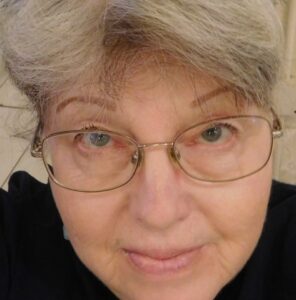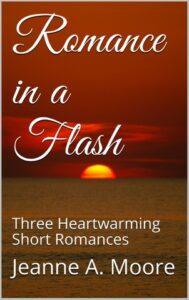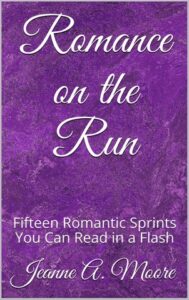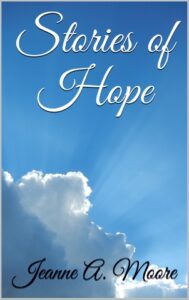I’d like to welcome Jeanne Moore to my website. Thank you, Jeanne, for taking the time to answer my questions.
I am delighted that you want to interview me.

Please tell us about your dream of writing.
I’ve always enjoyed writing but didn’t pursue it until after I retired from the eight-to-five office working world. Actually, it was two years after I retired that I got tired of being directionless and decided to pursue writing. I wrote a historical romance that I thought was going to be the next best seller. Well, it wasn’t. And after submitting it to several writing contests in which it received incredibly low scores, I decided I need to take some writing workshops. I joined Romance Writers of America and have been taking workshops through RWA ever since. My writing has steadily improved. I wrote several romances during this time and pitched them to every agent on QueryTracker. I also wrote and submitted short romances to Woman’s World Magazine. The magazine accepted and published one of those stories. Gripped with enthusiasm, I was turning out several stories a week that I submitted to Woman’s World. Over the course of a year, I wrote and submitted 76 short romances to this magazine, but only that one was accepted. It’s a very competitive market; they average about 4,000 romantic short story submissions per month.
One of my Facebook friends who had published on Amazon suggested that I collect the short romances that were not selected for publication into anthologies and publish them on Amazon. That’s when I decided to take the plunge and publish on Amazon through Kindle Direct Publishing (KDP).
Self-Publishing
I have an idea for an anthology of short stories, and I’d like to write and self-publish it, but I’m intimidated by the process of self-publishing.
Do you have any advice for anyone wanting to self-publish on Amazon?
Oh, yes, I do. My advice “go for it.” And, before getting started, find tutorials about Kindle Direct Publishing so you can familiarize yourself with KDP. The process will seem less intimidating if you do.
KDP/Amazon offers lots of help. They have extensive instructions on their website and have wonderful tutorials, both on their website and on YouTube. There’s so much information, it can seem overwhelming at first. But just start at the beginning.
I recommend starting with this KDP University YouTube video Getting Started With KDP. The video is just under 45 minus long.
Was it difficult to set up and use Kindle Direct Publishing?
It wasn’t difficult, but there definitely is a learning curve. Don’t be intimidated by the very large amount of information. In addition to watching Getting Started With KDP, take a look at the KDP Help Center. Then learn as you go. You can always look up what you need to know when you get stuck. Their instructions are very good.
Two of the things I really like about KDP are the Kindle Create and the Cover Create. Kindle Create will format your manuscript for an eBook and then you just upload that file to KDP. Unfortunately, there’s no comparable program for formatting paperbacks, but KDP offers plenty of help so that you can do it yourself. Cover Create assists you in creating your book cover for both eBooks and paperbacks.
Short Stories
I enjoy interviewing short story writers.
Could you give us details about Romance in a Flash and Romance on the Run?
Romance in a Flash was the first book I published on Amazon. It contains three of the short romances that Woman’s World did not select, and it was what I used to practice using KDP. Since it’s so short, I only published it in eBook form. Romance on the Run was the second book I published on Amazon and is a collection of fifteen of the stories the aforementioned magazine did not select. This time, I published it in both eBook and paperback format. It’s what I used to learn how to format a manuscript in Word for a paperback. Again, KDP does not have a program like Kindle Create to format books for paperback, but they do offer lots of instruction.


All the short romances in these collections are sweet romances with happily ever after endings.
Can you share information about the category, Short Reads on Amazon?
Amazon Short Reads are stories of one hundred pages or less; this category is further broken down by the length of time that it’s estimated that it will take to read the story (such as fifteen minutes, thirty minutes, etc.). You can get a feel for short reads here. Take a look at the menu on the left side of the screen for the categories.
When you publish your short story or collection of short stories, Amazon will automatically put it in the Short Reads category; authors can’t elect to be published in Short Reads.
Yes, you can publish just one short story on Amazon or you can publish a collection of short stories.
History
Congratulations! Your paperback edition of Stories of Hope was #1 and the Kindle edition made #2 in New Releases in Historical Fiction Anthologies on Amazon. Did I get my facts correct on that?
Yes, you got that correct. I am very pleased with that ranking.

Could you share information about Stories of Hope?
Stories of Hope is a collection of six historical stories about people who successfully overcame difficult situations. They all have happy endings. Two of the stories were inspired by real events that happened in American history. One incident was the Triangle Shirtwaist Factory fire in 1911 in New York City. The other one was inspired by the Orphan Train movement.
History is fascinating, and I enjoy reading about it. I’d like to tackle a historical short story someday.
Do you have any advice you’d like to share about researching history?
Yes. It is very important to do your research. Although your characters are fictional (and the towns where my characters live may also be fictional), it is important to be historically accurate. You might be able to stretch the truth a little bit, but, for example, you don’t want your characters traveling by train from New York City to San Francisco prior to May 10, 1869 when Leland Stanford drove the last spike that completed the first transcontinental railroad. If they cross the United States before then, it’s likely that they’d travel as far as they could by train and then take a stagecoach the rest of the way. And stagecoaches were not a comfortable long-haul ride for the passengers. There were no shock absorbers.
Libraries and librarians are invaluable resources. Most libraries have an “Ask a Librarian” feature and you can do this online. Public libraries are on the state, county and city levels. There are also university libraries, medical libraries and law libraries. Museums, archives and historical societies are also wonderful resources.
The librarians and contact people at museums and historical societies that I have contacted over the years have always been more than happy to assist me. Don’t feel you’re restricted to only contacting these institutions in your state. With the internet and email, you can contact them worldwide.
Historical newspapers are also a wonderful reference. There are sites that have digitized newspapers that can search online. One of the sites is the Library of Congress’s Chronicling America. The University of California at Davis offers digitized California newspapers in their California Digital Newspaper Collection. A search on the Internet will bring up other places where you can find newspapers online. Once the pandemic restrictions ease up, you may be able to find historic newspapers on microfilm at your library. For example, the Hawaii State Library’s main branch has a serials room where they house many of Hawaii’s newspapers from the past on microfilm rolls. This includes the English-language newspapers, Japanese-language newspapers and Hawaiian-language newspapers.
And of course, with the internet, world-wide research is at your fingertips.
I’d like to thank Jeanne for sharing the link to her Resources for Writers. She filled it with research information pertinent to historical writers, or for anyone who enjoys learning more about history. Once on the Resources for writers page, just scroll passed the Resources for Authors who Self Publish, and you’ll find a wonderful section full of historical resources.
Miscellaneous
Do you find Twitter beneficial for your writing career?
I don’t think I’ve generated any book sales so far from being on Twitter, but I like the opportunity it gives me to connect with writers and literary agents. You never know some of these contacts might be interested in buying your books.
I see you are a member of The Author’s Guild.
Could you share some information about the organization?
The Authors Guild offers many benefits. Some of them are legal help, seminars and events, a resource library and access to various web services like low-cost website building, domain names and web hosting. I mainly use their community forums to ask questions.
Conclusion
Do you have any news or updates you’d like to share?
Well, I am working on another collection of short historical fiction. There are six stories; I’ve finished the very rough drafts. Now the editing begins. And I’ve had a website for a couple of weeks now. I’ve had a book on how to create a website in WordPress for over a year now, and finally decided to just do it. I am continually updating the Resources for Writers page and adding blogs. My website is www.jeanneamoore.com
I’m really grateful for having activities that have kept me focused and busy during the pandemic. Otherwise, I’d be really upset with having to stay home most of the time!
Your readers can find my Amazon author page, which lists my books here
Be First to Comment